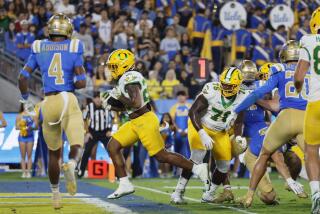The Big Game Just a Big Letdown for Cal : Stanford: The Cardinal’s 24-14 victory leaves the Bears last in Pac-10 and the coveted ax trophy in Palo Alto.
- Share via
PALO ALTO — There was a medium-sized upset Saturday in the Big Game.
In the 92nd football meeting of California and Stanford, which is always called the Big Game around these parts, 86,019 at Stanford Stadium found that Stanford’s 24-14 victory over favored Cal would answer at least one big question: Who’s finishing last?
For the second year in a row, it’s Cal. But let us put this thing in historical perspective.
The last time the Rose Bowl was at stake in the Big Game was 1971. The last time Stanford and Cal were 1-2 in the Pacific 10 Conference coming into their matchup was in 1937 when FDR was president the Big Game was an adolescent and still growing.
If the Big Game were the Super Bowl, this would have been Big Game LXXXXII (or if you prefer, XCII). There have been 92 years of games, but for the combatants, it must seem longer.
“I feel lousy right now,” said Coach Bruce Snyder as Cal thudded to 4-7.
Standing in the wake of a 3-8 season, Stanford Coach Denny Green proudly retained the game’s trophy, a 90-year-old ax that goes to the winner of the Big Game.
Green refused to downplay the significance of defeating his arch-rival, regardless of the circumstances of two losing teams just sticking a cork in a season. He said the Big Game is, after all, still pretty big.
“I’ll tell you what it is,” Green said. “This thing is so old, it goes back to the Barbary Coast concept almost. You’ve got that deep bickering like between husband and wife, brothers and sisters, or even worse, you and your mother-in-law.”
Few could have realized this hostility had such depth.
Cal, which was expected to follow consecutive stirring victories over Arizona and Washington State with a season-ending romp over Stanford, found instead a sorry way for quarterback Troy Taylor to bow out.
The Golden Bears finished in the Pac-10 cellar at 2-6, one game behind Stanford for the second consecutive year. Taylor closed out a college career that was often brilliant with another standout day in yet another losing cause--Cal was 14-27-3 in Taylor’s four years.
Taylor completed 29 of 57 passes for a career-best 377 yards. His total of 8,126 yards moved him past Stanford’s Jim Plunkett and Washington State’s Jack Thompson into fourth place on the Pac-10’s all-time passing yardage list.
Taylor threw a five-yard touchdown pass to get Cal within 21-14 in the fourth quarter, but he also had two passes intercepted--both by free safety Albert Richardson. The first one resulted in Stanford’s first touchdown to end a 35-yard drive, a nine-yard run by Jay Jay Lasley.
But it was the play Cal ran after Taylor’s touchdown pass that may have been the key to the game. Snyder called for an onsides kick, even though there was still 4:01 remaining and Cal had two timeouts.
Snyder’s move was strictly a no-confidence vote for his defense. Last in the Pac-10 in rushing defense, Cal had allowed Stanford to mount a 21-7 lead by virtue of an eight-play, 78-yard scoring drive that featured not a single pass by freshman quarterback Steve Smith. Stanford rushed for a season-high 229 yards.
On the critical drive, Lasley, Scott Eschelman and Galen Foster ran the ball to the 22-yard line, where 228-pound running back Tommy Vardell got the call and scored on a brutish burst up the middle.
That’s when Snyder opted for the onsides kick, which Ed McCaffrey recovered at the Cal 44.
Snyder explained his strategy: “Well, we weren’t doing a great job stopping their offense. . . . We didn’t want to end the game without having the ball again.”
They got it back once more with 34 seconds left, but after Taylor completed three passes and moved the ball 41 yards to the Stanford 13, he threw four incompletions and the ball went over to Stanford with five seconds left.
Stanford’s victory increased it’s lead in the Big Game series to 44-37-11 and also means it retains possession of the ax for another year.
The ax, which is now mounted on a 75-pound wooden plaque, has for years symbolized the Big Game. It was found in 1899 by Stanford students who thought it was an accurate symbolic representation of what they wanted to do to Cal’s football team.
But some Cal students stole the ax and kept it hidden until 1930 when 21 Stanford students concocted an elaborate ruse to get it back. Posing as Berkeley freshmen and student newspaper reporters, the Stanford group snatched the ax after persuading the Cal keeper of the ax to pose for a picture.
Flash bulbs temporarily blinded the keeper of the ax and Stanford students ran off with their prize to find a niche in school history. They are still called the Immortal 21.
Since then, there have been six other blade burglaries with Stanford leading in ax-nabbing, 4-3, including the last one, in 1978. This theft occurred in a parking lot and ended with the ax sliding across the hood of a Cadillac before it was finally swiped by three Stanford students, now known as the Infamous Three.
Saturday, 59 years after their immortality was bestowed, eight of the 10 surviving members of the Immortal 21 were honored before the game.
Green said it may sound corny, but as far as symbols go, the ax can still cut it.
“You know, we got pretty fired up playing for the axe,” he said. “It’s not often you can find a symbol to fight for. We’ll keep it for another year.”
More to Read
Go beyond the scoreboard
Get the latest on L.A.'s teams in the daily Sports Report newsletter.
You may occasionally receive promotional content from the Los Angeles Times.










